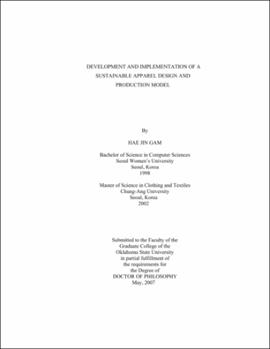| dc.contributor.advisor | Cao, Huantian | |
| dc.contributor.author | Gam, Hae Jin | |
| dc.date.accessioned | 2013-11-26T08:23:21Z | |
| dc.date.available | 2013-11-26T08:23:21Z | |
| dc.date.issued | 2007-05 | |
| dc.identifier.uri | https://hdl.handle.net/11244/6698 | |
| dc.description.abstract | Scope and Method of Study: Many environmental problems related to the apparel industry, such as toxicity in dyeing wastewater, could be minimized by apparel designers and manufacturers. McDonough and Braungart's 'Cradle to Cradle' model provides designers with a new way to design products and eliminate many environmental problems during the design phase of the product life cycle. However, no apparel design and production model considered the designer's role in environmental sustainability. The purpose of this study was to develop, implement, and evaluate an apparel design and production conceptual model by integrating 'Cradle to Cradle' into apparel design and production models (C2CAD) to provide sustainable production guidelines for apparel designers and manufacturers. The methods used for this study included the following steps (1)assess the price of organic and non-organic cotton yarns; (2)assess the colorfastness of selected natural and environmentally friendly and non-toxic dyes; (3)develop children's sweater designs; (4) produce prototype sweaters; and (5) assess consumer acceptance of organic cotton children's clothing. | |
| dc.description.abstract | Findings and Conclusions: The C2CAD model was developed by integrating McDonough and Braungart's "cradle to cradle" model into existing apparel design and production models (LaBat and Sokoloskwi, 1999; May-Plumlee and Little, 1998). The C2CAD model has four main steps: 1) problem definition and research, 2) sample making, 3) solution development and collaboration, and 4) production. Following the four steps and with an international collaboration similar to current apparel industry practices, "Four-season sustainability" children's knitwear was developed. Produced with an acceptable manufacturing cost, the products have good mechanical and color fastness performance. The investigation of consumers' opinions of environmentally friendly clothing was conducted, and recommendations for the apparel industry and future research were discussed. | |
| dc.format | application/pdf | |
| dc.language | en_US | |
| dc.rights | Copyright is held by the author who has granted the Oklahoma State University Library the non-exclusive right to share this material in its institutional repository. Contact Digital Library Services at lib-dls@okstate.edu or 405-744-9161 for the permission policy on the use, reproduction or distribution of this material. | |
| dc.title | Development and implementation of a sustainable apparel design and production model | |
| dc.contributor.committeeMember | Farr, Cheryl Ann | |
| dc.contributor.committeeMember | Muske, Glenn | |
| dc.contributor.committeeMember | Warde, William | |
| dc.contributor.committeeMember | Kang, Mihyun | |
| osu.filename | Gam_okstate_0664D_2307.pdf | |
| osu.accesstype | Open Access | |
| dc.type.genre | Dissertation | |
| dc.type.material | Text | |
| thesis.degree.discipline | Human Environmental Sciences | |
| thesis.degree.grantor | Oklahoma State University | |
